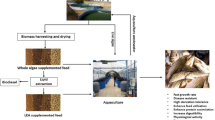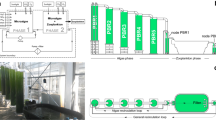Abstract
Algae are utilized diversely in aquaculture, but theirmain applications are related to nutrition. They areused in toto, as a sole component or as a foodadditive to supply basic nutrients, color the flesh ofsalmonids or for other biological activities. The needfor nutritional sources safer than traditional animalproducts has renewed interest in plants in general andalgae in particular. This report deals principallywith the nutritional role of microalgae inaquaculture.The larvae of molluscs, echinoderms andcrustaceans as well as the live prey of some fishlarvae feed on microalgae. Though attempts have beenmade to substitute inert particles for thesemicro-organisms which are difficult to produce,concentrate and store, only shrimp and live prey forfish will accept inert food, and only shrimp accept itfully. Several studies have confirmed that a live,multi-specific, low-bacteria microalgal biomassremains essential for shellfish hatcheries. Majoradvances are expected from new production systemdesigns and operations, from batch-run open tanks tomore sophisticated continuously run and closed loopreactors. Studies are underway to simplify hatcheryoperations by replacing biomass produced on-site withrun-times by that produced and preserved elsewhere.Although still promising, they have not given rise, sofar, to any application for molluscs. Otherapplications of microalgae in aquaculture, from greenwater to making salmon flesh pinker, are examined.Whether produced on or off-site, there remains thequestion of cost effectiveness of microalgalproduction systems. This can only be achieved bysubstantial upscaling and improved quality control.
Similar content being viewed by others
References
Apt KE, Behrens PW (1999) Commercial developments in microalgal biotechnology. J. Phycol. 35: 215-226.
Barille L, Bougrier S, Geairon P, Robert JM (1994) Experimental feeding of the oyster Crassostrea gigas (Thunberg) with three populations of different-sized modes of the diatom Haslea ostrearia Simonsen. Oceanol. Acta 17: 201-210.
Benemann JR (1992) Microalgae aquaculture feeds, J. appl. Phycol. 4: 233-245.
Borowitzka MA, Huisman JM, Osborn A (1991) Culture of the astaxanthin-producing green alga Haematococcus pluvialis. 1. Effects of nutrients on growth and cell type. J. appl. Phycol. 3: 295-304.
Borowitzka MA (1996) Closed algal photobioreactors: Design considerations for large-scale systems. J. mar. Biotechn. 4: 185-191.
Dhert P, Divanach P, Kentouri M, Sorgeloos P (1998) Rearing techniques for difficult fish larvae. World Aquacult. 29: 48-55.
Gladue RM (1998) Heterotrophic microalgae as an inexpensive feed for rotifer. J. Shellfish Res. 17: 325-326.
Grizel H, Tige G (1982) Evolution of the haemocytic disease caused by Bonamia ostreae. In Invertebrate Pathology and Microbial Control. Society for Invertebrate Pathology, Brighton, UK, pp. 258-260.
Grizel H, Heral M (1991) Introduction into France of the Japanese oyster (Crassostrea gigas). J. Cons. CIEM 47: 399-403.
Longhurst A, Sathyendranah S, Platt T, Caverhill C (1995) An estimate of global primary production in the ocean from satellite radiometer data. J. Plankton Res. 17: 1245-1271.
Muller-Feuga A (1997) Microalgues Marines, Les Enjeux de la Recherche. Ifremer, Plouzané, France, 35 pp.
Muller-Feuga A, Gudin C, Grima EM, Minkoff G, Tredici M, Raineri S, Robert R (1998) Microalgae biomass from photobioreactors as food for fish and shellfish larvae. European Comm. Proj. AIR1-CT92-286. Third Europ. Marine Sc. & Tech. Conf., Project synopses, Lisbon-Portugal 20: 33-35.
Newkirk GF (1991) Aquaculture in Sungo Bay, China. Austasia Aquacult. 5: 8-11.
Paillard C, Maes P, Oubella R (1994) Brown ring disease in clams. Annu. Rev. Fish Dis. 4: 219-240.
Pauly D, Christensen V (1995) Primary production required to sustain global fisheries. Nature 374: 255-257.
Robert R, Trintignac P (1997) Substitues for live microalagae in mariculture: A review. Aquat. Living Resour. 10: 315-327.
Rosenberry B (ed.) (1998) World Shrimp Farming. Shrimp News Int. San Diego, CA, USA, 328 pp.
Sanderson GW, Jolly AF (1994) The value of Phaffia yeast as a feed ingredient for salmonid fish. Aquaculture 124: 193-200.
Shatz Y (1999) Fishstat Plus 2.19, FAO, Rome, Italy.
Tang Q, Fang J (1999) Aquaculture of scallops in China. Abstracts of the 12th Int. Pectinid Workshop, Bergen-Norway, 1 pp.
Verdelho Vieira V, Baylina N (1995) Necton microalgae biotechnology directory. Universidade Catolica Portuguesa, 131 pp.
Author information
Authors and Affiliations
Rights and permissions
About this article
Cite this article
Muller-Feuga, A. The role of microalgae in aquaculture: situation and trends. Journal of Applied Phycology 12, 527–534 (2000). https://doi.org/10.1023/A:1008106304417
Issue Date:
DOI: https://doi.org/10.1023/A:1008106304417




